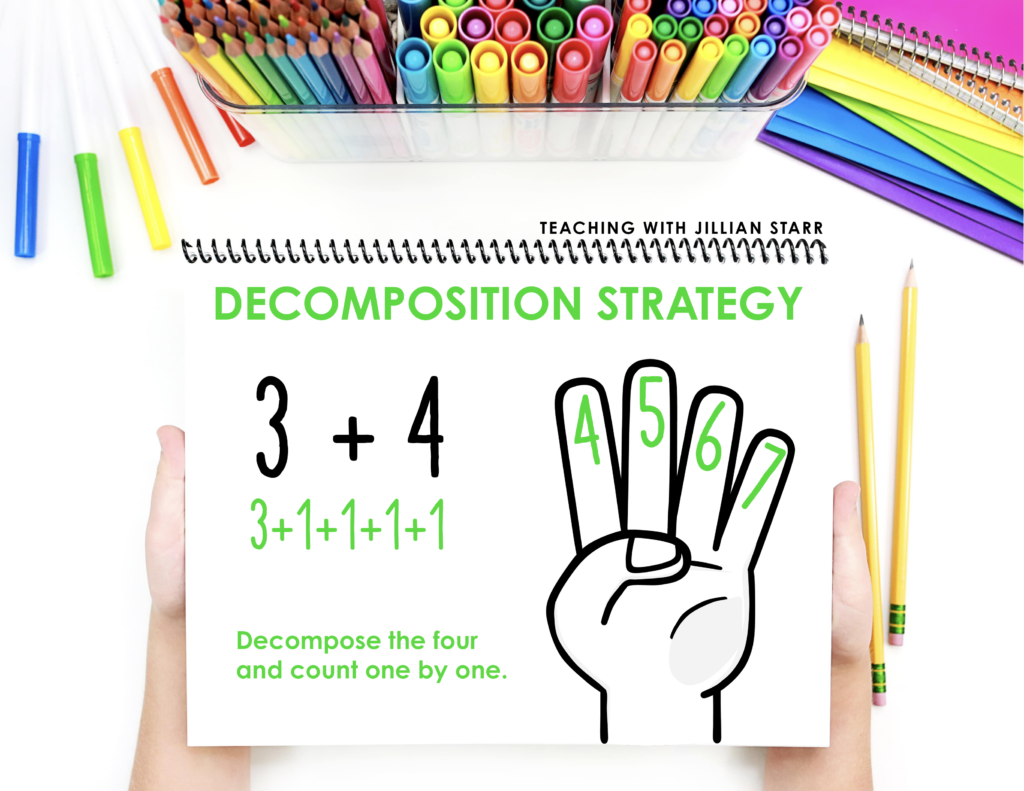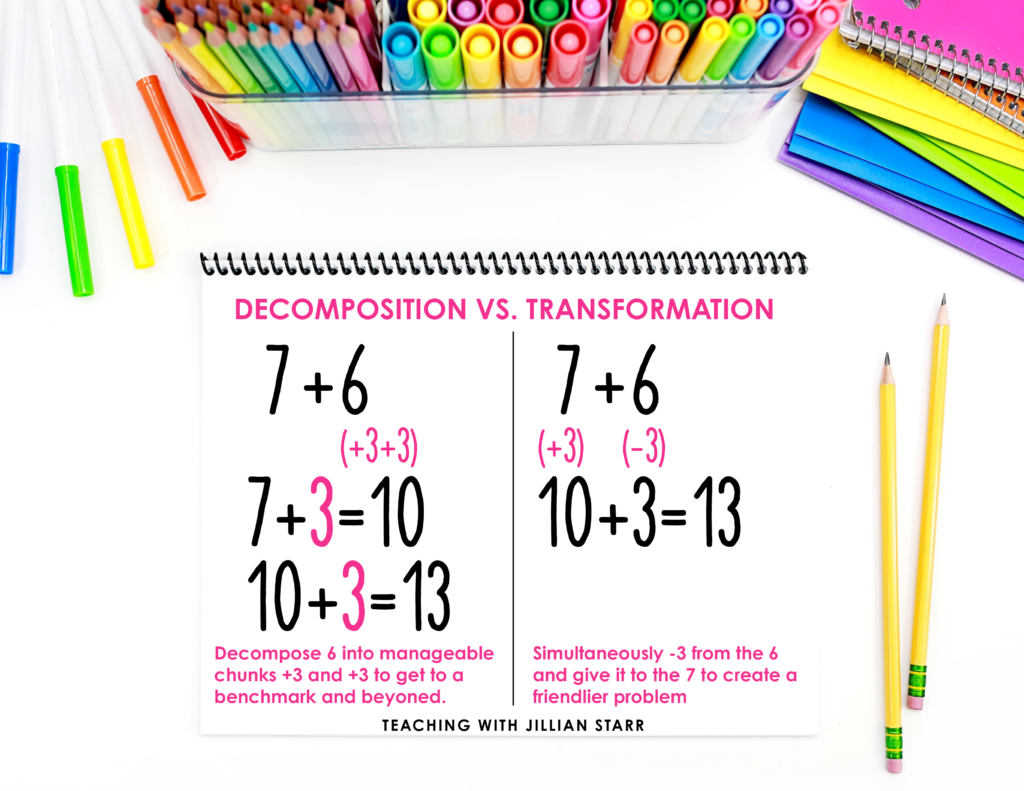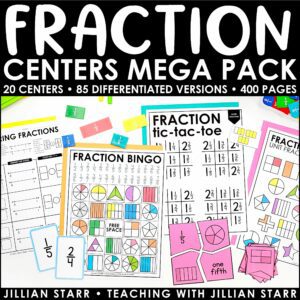
We’re digging into another addition strategy in this post, and this one is really versatile! In this post, we’re examining The Decomposition Strategy.
Other strategies we’ve covered include:
In previous discussions, I’ve talked about the importance of allowing the natural development of these addition strategies. This means that our job gets to build students’ number sense so they can start to see the connections between numbers. When they see the relationships between numbers, they will begin to develop strategies independently.
So, when we talk about the Decomposition Strategy here, I am not encouraging teachers to make this an explicit lesson. Instead, I want us to understand each of these different addition strategies so that we can recognize them when they show up in our classroom.
That’s not to say we can’t point out strategies when we see them, or even highlight them in front of other students during math discussions! In fact, those are both really great ways to:
- Encourage students to recognize their own strategies
- Reflect on their own math process
- Work to articulate that process to their peers
- Allow other students to be inspired to try a new strategy that may be more efficient than their own
Let’s take a look at the Decomposition Strategy so we can better identify it when we see it with our students. Are you ready?
What is the Decomposition Strategy for Addition?
The “Decomposition” of the Decomposition Strategy refers to breaking down one of the addendeds into smaller, friendlier pieces. For example, a student might see the problem 57+26 and decide to break 26 down into manageable chunks for adding.

The child might break the problem into 57+3+20+3. This is to successfully reach benchmark numbers like 60 and 80. Then they can add on the final 3 to get to 83.
When we are decomposing a number into manageable chunks, what those chunks look like may vary from student to student. This is because when we say manageable chunks, manageable can mean something different for each child.


Another student may not be confident enough yet to approach 57+26 in the same way. Using the Decomposition Strategy for them might look like 57+10+10+1+1+1+3. They understand the relationship between ten more and ten less with numbers, so they decomposed the 20 into two separate jumps of 10. Then, they decomposed 6 into jumps of 1 until they reached a friendly number like 80. Then they felt confident enough to add on the remaining 3 to get to 83.
Decomposition is a strategy that can build over time as a student becomes more and more familiar with number relationships and working with larger chunks.
What does the Decomposition Strategy look like in First Grade?
In first grade, students are learning to add and subtract numbers through 20. For many young students, early addition looks like counting on fingers or with manipulatives. These are both great examples of decomposition! How?


Well, let’s think about a student who wants to add 3+4. They may start with three fingers up on one hand. Then, one by one on different hand, raise a new finger as they count “4, 5, 6, 7,” stopping when they recognize four fingers on that hand are up. They have just decomposed the 4 into 1+1+1+1.
A student who is further along in their understanding may be working decomposing addends to reach friendly numbers. For example, a student may approach 7+6 as 7+3+3.


Now, I know this may look similar to what we discussed when looking at the transformation strategy (where a student would shift 7+6 to 10+3), but here the student isn’t altering their addition sentence. They may not be ready to transform two numbers simultaneously to create a friendlier sentence. Instead, they are seeking out friendly numbers by breaking apart one of the addends into smaller pieces.
What does the Decomposition Strategy look like in Second Grade?
Like we showed in our first example, second graders will likely use the Decomposition Strategy to reach larger benchmark numbers. The way students decompose addends will become more efficient over time. Their chunks will become larger as they become more and more confident with adding larger amounts.



The way students show their thinking with this strategy will also vary from child to child. Some will show it with addition sentences. Others may use a number line. Still, others may simply use arrows or lines to show the process of their decomposing.
Again, this strategy is incredibly flexible and can be used by students at many stages in their understanding. Our goal with this strategy is simply for it to become more and more efficient over time.
What does the Decomposition Strategy look like in Third Grade?
When we move into third grade, we get to see students becoming more and more efficient with the decomposition strategy in addition and even generalizing it to other operations.
They might use decomposition to break up three and four-digit numbers into larger chunks. They may feel comfortable with adding hundreds and thousands at this point. They may also continue to use open number lines or other visuals to keep track of parts.
As third graders move into multiplication, we get to see students build on their understanding of decomposition as they work with partial products in multiplication. Remember that decomposition simply means breaking numbers down into manageable chunks.


With multiplication, students will often break a problem into more manageable multiplication expressions using partial products. Here we see a student breaking 8×7 down into 8×5 and 8×2 to get their answer.
The decomposition strategy is wonderfully flexible and students can become more and more efficient with it over time. We don’t need to have students learn how to do a single math problem in three or four different ways, but we *do* want students to see relationships between numbers that will guide them to the most efficient strategy. Sometimes this will be the decomposition strategy, but other times it might be compensation or transformation!
EXCITING NEWS!
First Grade Teachers, something big is coming! If you’re someone who loves digging into math concepts, or wants to become a better math teacher for your students, I’d love for you to join me. If you’d like to be the first to find out more, enter your info below!
Get on the Waitlist!
1st Grade Teachers! Something big is coming this June and I will be inviting a small group of teachers to get a first glimpse before it becomes available for everyone. If you’d like to be the first to find out more, just enter your info below!











Leave a Comment